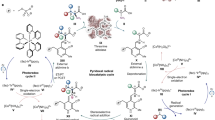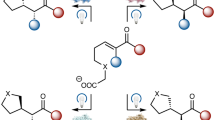Abstract
Multicomponent reactions—those where three or more substrates combine into a product—have been highly useful in rapidly building chemical building blocks of increased complexity1, but achieving this enzymatically has remained rare2,3,4,5. This limitation primarily arises because an enzyme’s active site is not typically set up to address multiple substrates, especially in cases involving multiple radical intermediates6. Recently, chemical catalytic radical sorting has emerged as an enabling strategy for a variety of useful reactions7,8. However, making such processes enantioselective is highly challenging owing to the inherent difficulty in the stereochemical control of radicals9. Here we repurpose a thiamine-dependent enzyme10,11 through directed evolution and combine it with photoredox catalysis to achieve a photobiocatalytic enantioselective three-component radical cross-coupling. This approach combines three readily available starting materials—aldehydes, α-bromo-carbonyls and alkenes—to give access to enantioenriched ketone products. Mechanistic investigations provide insights into how this dual photocatalyst–enzyme system precisely directs the three distinct radicals involved in the transformation, unlocking enzyme reactivity. Our approach has achieved exceptional stereoselectivity, with 24 out of 33 examples achieving ≥97% enantiomeric excess.
This is a preview of subscription content, access via your institution
Access options
Access Nature and 54 other Nature Portfolio journals
Get Nature+, our best-value online-access subscription
$32.99 / 30 days
cancel any time
Subscribe to this journal
Receive 51 print issues and online access
$199.00 per year
only $3.90 per issue
Buy this article
- Purchase on SpringerLink
- Instant access to full article PDF
Prices may be subject to local taxes which are calculated during checkout




Similar content being viewed by others
Data availability
All data are available in the main text or Supplementary Information, and from the Cambridge Crystallographic Data Centre (CCDC; http://www.ccdc.cam.ac.uk/structures/); crystallographic data are available free of charge under CCDC reference numbers 2345903 (4a), 2345905 (4b) and 2345907 (4ab).
References
Dömling, A., Wang, W. & Wang, K. Chemistry and biology of multicomponent reactions. Chem. Rev. 112, 3083–3135 (2012).
Chen, K. & Arnold, F. H. Engineering new catalytic activities in enzymes. Nat. Catal. 3, 203–213 (2020).
Reetz, M. T. Biocatalysis in organic chemistry and biotechnology: past, present, and future. J. Am. Chem. Soc. 135, 12480–12496 (2013).
Bell, E. L. et al. From nature to industry: harnessing enzymes for biocatalysis. Science 382, eadh8615 (2023).
Thorpe, T. W., Marshall, J. R. & Turner, N. J. Multifunctional biocatalysts for organic synthesis. J. Am. Chem. Soc. 146, 7876–7884 (2024).
Leifert, D. & Studer, A. The persistent radical effect in organic synthesis. Angew. Chem. Int. Ed. 59, 74–108 (2020).
Chen, R. et al. Alcohol–alcohol cross-coupling enabled by SH2 radical sorting. Science 383, 1350–1357 (2024).
Wang, J. Z., Lyon, W. L. & MacMillan, D. W. C. Alkene dialkylation by triple radical sorting. Nature 628, 104–109 (2024).
Mondal, S. et al. Enantioselective radical reactions using chiral catalysts. Chem. Rev. 122, 5842–5976 (2022).
Breslow, R. On the mechanism of thiamine action. IV.1 Evidence from studies on model systems. J. Am. Chem. Soc. 80, 3719–3726 (1958).
Brandt, G. S. et al. Probing the active center of benzaldehyde lyase with substitutions and the pseudosubstrate analogue benzoylphosphonic acid methyl ester. Biochemistry 47, 7734–7743 (2008).
Hug, J. J., Krug, D. & Müller, R. Bacteria as genetically programmable producers of bioactive natural products. Nat. Rev. Chem. 4, 172–193 (2020).
Singh, K. et al. Reconstruction of a fatty acid synthesis cycle from acyl carrier protein and cofactor structural snapshots. Cell 186, 5054–5067.e5016 (2023).
Benítez-Mateos, A. I., Roura Padrosa, D. & Paradisi, F. Multistep enzyme cascades as a route towards green and sustainable pharmaceutical syntheses. Nat. Chem. 14, 489–499 (2022).
Huffman, M. A. et al. Design of an in vitro biocatalytic cascade for the manufacture of islatravir. Science 366, 1255–1259 (2019).
McIntosh, J. A. et al. A kinase-cGAS cascade to synthesize a therapeutic STING activator. Nature 603, 439–444 (2022).
Thorpe, T. W. et al. Multifunctional biocatalyst for conjugate reduction and reductive amination. Nature 604, 86–91 (2022).
Tseliou, V. et al. Enantioselective biocascade catalysis with a single multifunctional enzyme. Angew. Chem. Int. Ed. 61, e202212176 (2022).
Ouyang, Y., Turek-Herman, J., Qiao, T. & Hyster, T. K. Asymmetric carbohydroxylation of alkenes using photoenzymatic catalysis. J. Am. Chem. Soc. 145, 17018–17022 (2023).
Harrison, W., Huang, X. & Zhao, H. Photobiocatalysis for abiological transformations. Acc. Chem. Res. 55, 1087–1096 (2022).
Emmanuel, M. A. et al. Photobiocatalytic strategies for organic synthesis. Chem. Rev. 123, 5459–5520 (2023).
Sorigue, D. et al. An algal photoenzyme converts fatty acids to hydrocarbons. Science 357, 903–907 (2017).
Sorigue, D. et al. Mechanism and dynamics of fatty acid photodecarboxylase. Science 372, eabd5687 (2021).
Trimble, J. S. et al. A designed photoenzyme for enantioselective [2+2] cycloadditions. Nature 611, 709–714 (2022).
Sun, N. et al. Enantioselective [2+2]-cycloadditions with triplet photoenzymes. Nature 611, 715–720 (2022).
Emmanuel, M. A., Greenberg, N. R., Oblinsky, D. G. & Hyster, T. K. Accessing non-natural reactivity by irradiating nicotinamide-dependent enzymes with light. Nature 540, 414–417 (2016).
Biegasiewicz, K. F. et al. Photoexcitation of flavoenzymes enables a stereoselective radical cyclization. Science 364, 1166–1169 (2019).
Huang, X. et al. Photoenzymatic enantioselective intermolecular radical hydroalkylation. Nature 584, 69–74 (2020).
Huang, X. et al. Photoinduced chemomimetic biocatalysis for enantioselective intermolecular radical conjugate addition. Nat. Catal. 5, 586–593 (2022).
Peng, Y. et al. Photoinduced promiscuity of cyclohexanone monooxygenase for the enantioselective synthesis of α-fluoroketones. Angew. Chem. Int. Ed. 61, e202211199 (2022).
Cheng, L. et al. Stereoselective amino acid synthesis by synergistic photoredox-pyridoxal radical biocatalysis. Science 381, 444–451 (2023).
Zhao, B. et al. Direct visible-light-excited flavoproteins for redox-neutral asymmetric radical hydroarylation. Nat. Catal. 6, 996–1004 (2023).
Xu, Y. et al. A light-driven enzymatic enantioselective radical acylation. Nature 625, 74–78 (2024).
Shi, Q. et al. Single-electron oxidation-initiated enantioselective hydrosulfonylation of olefins enabled by photoenzymatic catalysis. J. Am. Chem. Soc. 146, 2748–2756 (2024).
Wang, T.-C. et al. Stereoselective amino acid synthesis by photobiocatalytic oxidative coupling. Nature 629, 98–104 (2024).
Ouyang, Y., Page, C. G., Bilodeau, C. & Hyster, T. K. Synergistic photoenzymatic catalysis enables synthesis of α-tertiary amino acids using threonine aldolases. J. Am. Chem. Soc. 146, 13754–13759 (2024).
Tseliou, V. et al. Stereospecific radical coupling with a non-natural photodecarboxylase. Nature 634, 848–854 (2024).
Hailes, H. C. et al. Engineering stereoselectivity of ThDP-dependent enzymes. FEBS J. 280, 6374–6394 (2013).
Xu, J. et al. Stereodivergent protein engineering of a lipase to access all possible stereoisomers of chiral esters with two stereocenters. J. Am. Chem. Soc. 141, 7934–7945 (2019).
Liu, K., Schwenzer, M. & Studer, A. Radical NHC catalysis. ACS Catal. 12, 11984–11999 (2022).
Parsaee, F. et al. Radical philicity and its role in selective organic transformations. Nat. Rev. Chem. 5, 486–499 (2021).
Xiao, X. et al. Biomimetic asymmetric catalysis. Sci. China Chem. 66, 1553–1633 (2023).
Lovelock, S. L. et al. The road to fully programmable protein catalysis. Nature 606, 49–58 (2022).
Acknowledgements
We thank D. Ye, Y. Wang and Z. Shi from NJU for sharing their equipment. We thank the financial support from the National Natural Science Foundation of China (22277053, 22122305, 21927814 and 223B2703), the National Key Research and Development Program of China (2022YFA0913000 and 2019YFA0405600), Natural Science Foundation of Jiangsu Province (BK20220760), Fundamental Research Funds for the Central Universities 0205/14380346, Excellent Research Program of Nanjing University (ZYJH004), and the Strategic Priority Research Program of Chinese Academy of Sciences (XDB0960201 and XDB0540200).
Author information
Authors and Affiliations
Contributions
Z.X. developed the system and performed most of the synthetic experiments. F.L. performed the protein mutagenesis. J.F. performed the theoretical calculations under the supervision of B.W. L.Y. and A.L. carried out the electron paramagnetic resonance measurements. Z.W., B.Z. B.C., H.P., Y.X. and C.W. assisted in the synthetic experiments and mechanistic investigations. Y.Z. performed the X-ray crystal structure analysis. X.H. and B.W. wrote the paper with input from all authors. X.H. coordinated and conceived of the project.
Corresponding authors
Ethics declarations
Competing interests
The authors declare no competing interests.
Peer review
Peer review information
Nature thanks Dominic Campopiano, Julian West and the other, anonymous, reviewer(s) for their contribution to the peer review of this work.
Additional information
Publisher’s note Springer Nature remains neutral with regard to jurisdictional claims in published maps and institutional affiliations.
Supplementary information
Supplementary Information
This file contains Supplementary Figs. 1–18, Tables 1–20, Methods and References.
Rights and permissions
Springer Nature or its licensor (e.g. a society or other partner) holds exclusive rights to this article under a publishing agreement with the author(s) or other rightsholder(s); author self-archiving of the accepted manuscript version of this article is solely governed by the terms of such publishing agreement and applicable law.
About this article
Cite this article
Xing, Z., Liu, F., Feng, J. et al. Synergistic photobiocatalysis for enantioselective triple-radical sorting. Nature 637, 1118–1123 (2025). https://doi.org/10.1038/s41586-024-08399-5
Received:
Accepted:
Published:
Issue date:
DOI: https://doi.org/10.1038/s41586-024-08399-5
This article is cited by
-
Photobiocatalytic benzylic C–H acylation enabled by the synergy of a thiamine-dependent enzyme, an organophotocatalyst and hydrogen-atom transfer
Nature Synthesis (2025)
-
Electricity-driven enzymatic dynamic kinetic oxidation
Nature (2025)
-
Pushing the boundaries of biocatalysis
Nature Catalysis (2025)



